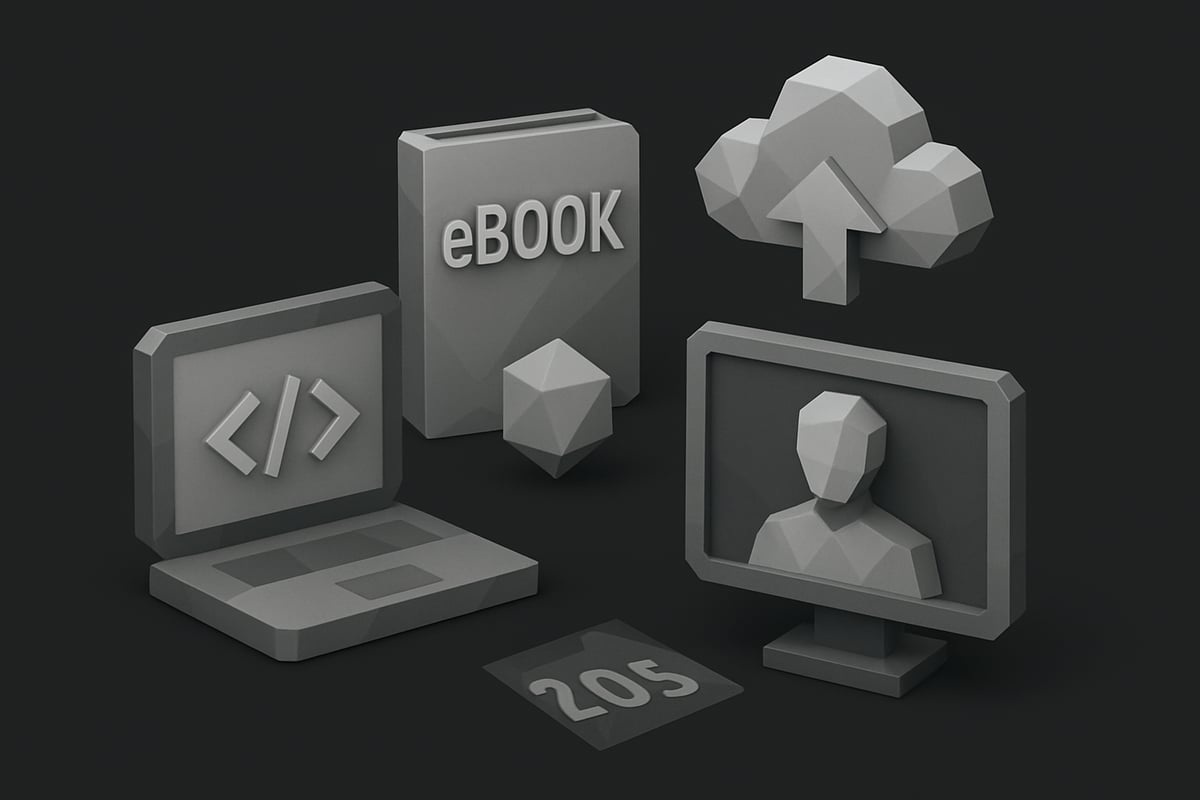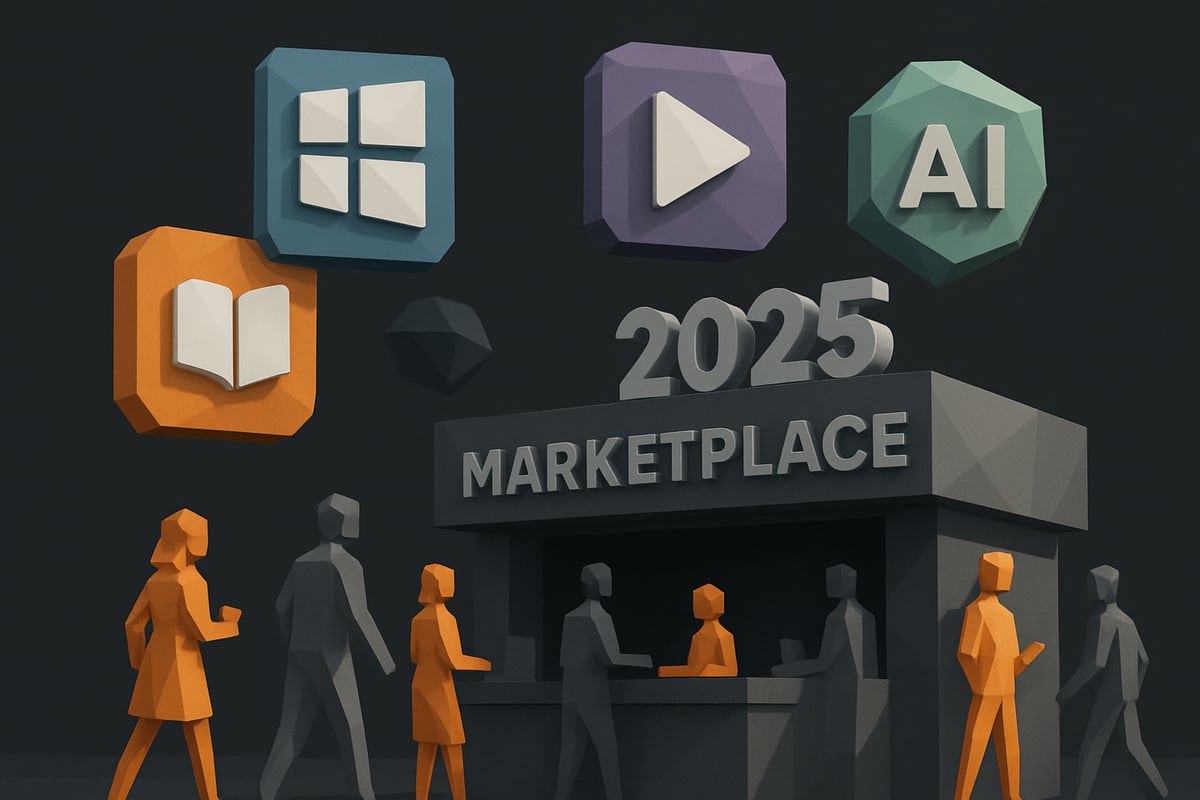The world of digital products and services is changing at breakneck speed, reshaping how we work, create, and connect. In 2025, innovation and opportunity are exploding, making this space more relevant than ever for entrepreneurs, creators, and businesses.
This essential guide breaks down everything you need to know about digital products and services in 2025. Discover crucial definitions, explore the latest trends, and learn how to leverage emerging tools for growth and engagement.
Ready to unlock new revenue streams and efficiencies? Dive in for actionable insights and expert strategies that will position you at the forefront of the digital revolution.
Defining Digital Products and Services in 2025
The world of digital products and services is rapidly expanding as we approach 2025. Understanding what sets these offerings apart—and how they’re reshaping business and consumer behavior—is essential for anyone looking to thrive in the digital economy.

What Are Digital Products?
Digital products are intangible goods delivered electronically, offering instant access and eliminating the need for physical inventory or shipping. They include a wide range of offerings, such as:
- Software applications and SaaS platforms
- eBooks and online courses
- Digital art and design templates
- Code snippets and business resources
Unlike physical goods, digital products can be sold globally with minimal distribution cost, making them highly scalable. Market projections suggest the value of digital products will continue climbing in 2025, fueled by trends like AI-powered tools and interactive content. For fresh insights, check out the latest Digital Product Statistics 2025, which highlights growth areas such as online learning and software.
The benefits for both consumers and businesses are clear: instant access, broad reach, and adaptability to emerging needs. As digital products and services evolve, expect even more innovative formats and delivery methods.
What Are Digital Services?
Digital services refer to activities or expertise delivered and consumed online, often tailored to individual client needs. Popular examples include:
- Virtual consultations and coaching
- Web design and digital marketing
- Streaming and cloud computing
- Virtual assistance and managed IT
Unlike digital products, digital services typically involve ongoing interaction, customization, and real-time problem-solving. The digital service sector is experiencing significant growth, with new models like remote-first delivery and subscription-based consulting gaining traction.
Accessibility is a major advantage, allowing providers to reach clients worldwide and disrupt traditional service industries. In 2025, expect to see even more innovative digital products and services, with cloud-based solutions and health teleconsulting leading the way.
Digital Products vs. Digital Services: Key Differences
Understanding the distinction between digital products and services helps clarify their unique value. Here’s a quick comparison:
| Digital Products | Digital Services | |
|---|---|---|
| Delivery | Instant download/access | Scheduled/real-time |
| User Role | Self-service | Provider interaction |
| Monetization | One-time sales/licensing | Subscriptions/retainers |
| Scalability | Highly scalable | Limited by provider |
| Example | eBook | Online coaching |
Digital products offer autonomy, while services thrive on interaction and support. Intellectual property concerns differ: products often require copyright protection, while services may focus on contracts and confidentiality. Consumers expect responsive support for services, but self-serve resources for products.
As digital products and services converge, businesses must address shifting expectations, legal issues, and evolving support needs to stay competitive.
Top Categories and Innovations in Digital Products & Services
The world of digital products and services is evolving rapidly, opening up brand-new opportunities for creators, entrepreneurs, and businesses. In 2025, the landscape is more dynamic and diverse than ever, with fresh categories and innovations changing the way we build, buy, and use digital solutions.

Major Digital Product Categories in 2025
Digital products and services cover a wide range of categories, each with its own set of trends and growth drivers. In 2025, software and SaaS tools remain at the forefront, powering productivity, collaboration, and niche workflows for users worldwide.
eLearning is experiencing explosive growth, with courses, certifications, and microlearning platforms catering to lifelong learners. Digital media—such as eBooks, music, stock photos, and design assets—continues to be a staple for both consumers and creators.
Templates and tools like website themes, code snippets, and business resources help users launch projects faster. AI-powered products, including content generators, chatbots, and advanced analytics, are transforming how people interact with technology. Low-code and no-code platforms are also making it easier for non-technical users to create their own digital products and services.
For a deeper dive into these categories, check out this Types of Digital Products Explained guide.
Market data shows AI products and microlearning platforms are among the fastest-growing segments. As a result, the digital products and services ecosystem is more accessible and innovative than ever.
Leading Digital Service Segments in 2025
Digital services have become essential for businesses and consumers seeking flexibility and expertise. Marketing and SEO services top the list, with brands investing in social media, influencer partnerships, and content creation.
Cloud-based solutions provide scalable storage, infrastructure, and seamless SaaS integrations. Virtual consulting services, including coaching, therapy, and business advisory, are thriving thanks to remote-first models.
Creative services—like graphic design, video editing, and copywriting—are in high demand, helping brands stand out in crowded markets. Entertainment and streaming platforms continue to attract global audiences with live and on-demand content.
Health and wellness services, such as telehealth, fitness training, and nutrition advice, are increasingly popular. The rise of remote-first service delivery models means digital products and services are accessible to anyone, anywhere, driving further growth.
Emerging Trends and Innovations
The digital products and services industry is being reshaped by cutting-edge technologies and new business models. Artificial intelligence and automation are enabling personalized user experiences and predictive tools. Blockchain and NFTs are introducing digital ownership and powering decentralized marketplaces.
Augmented reality (AR) and virtual reality (VR) are creating immersive environments for learning, shopping, and entertainment. Subscription and membership models are gaining traction, offering community-driven value and recurring revenue.
Integration and interoperability are on the rise, with API-first products and cross-platform services allowing seamless workflows. AI-driven video editing tools are a prime example of how automation is streamlining creative processes.
Adoption rates of AI and AR are climbing fast, signaling a bright future for digital products and services that embrace these innovations.
Marketplaces and Distribution Platforms
Digital products and services reach users through a variety of marketplaces and platforms. Leading options include app stores, Udemy, Shopify, Envato, and Fiverr, each catering to different types of creators and buyers.
Niche marketplaces like Creative Market, Gumroad, and Teachable offer specialized environments for selling digital assets and courses. Direct-to-consumer (DTC) models empower creators to sell on their own websites, controlling branding and user relationships.
Platform fees and revenue share structures vary, so understanding the pros and cons of each is crucial. Discoverability and competition are key considerations—selling on established platforms provides built-in audiences, while independent sales offer greater control.
User reviews and social proof play a significant role in driving sales. Creator-driven marketplaces are growing rapidly, making it easier than ever to launch and scale digital products and services in 2025.
Creating and Monetizing Digital Products & Services
Bringing digital products and services to life in 2025 is both an art and a science. From the spark of an idea to retaining loyal users, every stage demands strategy, creativity, and a focus on the evolving digital landscape.

The Creation Process: From Idea to Launch
Every great digital product or service starts with a clear idea and a real need. Begin by researching trends and pinpointing gaps where digital products and services can truly shine. Tools like surveys, keyword research, and competitor analysis help validate your concept before investing heavily.
Once you’ve validated demand, sketch out a minimum viable product (MVP). This lean version lets you gather feedback and refine your offering. Use platforms like no-code builders, learning management systems, or SaaS frameworks to speed up development. Focus on intuitive UX, since users expect seamless experiences from digital products and services.
Iterate quickly by testing with beta users, collecting feedback, and making improvements. Launching successfully means building anticipation—consider pre-launch email lists, sneak peeks, or launch webinars. For a deep dive into the step-by-step process, check out this Building Digital Products Guide.
For example, launching an online course in 2025 involves identifying an in-demand topic, creating engaging modules with interactive media, and using a platform that supports adaptive learning. The journey from idea to launch is about balancing speed, quality, and user feedback to maximize your digital products and services' impact.
Monetization Strategies for 2025
Monetizing digital products and services in 2025 means thinking beyond traditional sales. One-time purchases remain popular for assets like templates or eBooks, but recurring revenue is on the rise. Subscription models are dominating SaaS, membership sites, and premium content platforms.
Consider freemium strategies—offer a basic version for free and entice users to upgrade. Bundling complementary digital products and services can boost perceived value and increase average order size. Affiliate programs and partnerships open new revenue streams by leveraging other creators’ audiences.
Licensing and white-labeling let others resell your digital products and services under their brand, expanding reach. Microtransactions and pay-per-use models work well for app features or digital media.
Here’s a quick comparison:
| Model | Best For | Revenue Type |
|---|---|---|
| One-time sale | eBooks, templates | Single |
| Subscription | SaaS, memberships | Recurring |
| Freemium | Apps, online tools | Upsell |
| Licensing | Software, assets | Passive |
According to industry data, subscription-based digital products and services have seen double-digit growth year over year, reflecting shifting consumer preferences.
Marketing and Distribution Tactics
Effective marketing is crucial for standing out in the crowded world of digital products and services. Start with content marketing—blog posts, video tutorials, and podcasts establish authority and drive organic traffic. Leverage paid ads on social platforms and search engines for targeted reach, or partner with influencers to tap into new audiences.
Email marketing remains a powerful tool for nurturing leads and launching new digital products and services. Automate follow-ups and segment lists for personalized campaigns. Optimize your website and product pages for SEO, ensuring your digital products and services are discoverable when users search.
Social proof is key: collect user reviews and testimonials to build trust. Foster a community around your offering—discussion forums, social groups, or live Q&As increase engagement and retention.
For instance, a SaaS tool might go viral through a creative video campaign, leveraging both paid ads and organic shares. Combining multiple tactics ensures your digital products and services reach their ideal users and maintain momentum in the market.
User Engagement and Retention
Launching is just the beginning—the real challenge is keeping users engaged with your digital products and services. Start with a smooth onboarding process that guides new users and showcases core benefits. Personalization, such as adaptive content or tailored recommendations, keeps experiences fresh.
Gamification—think badges, progress bars, or rewards—encourages continued use. Invest in robust customer support: chatbots for instant answers, knowledge bases for self-help, and live chat for complex issues.
Community features, like discussion boards or user-generated content, foster belonging and increase the stickiness of your digital products and services. Regularly analyze user behavior and feedback to identify improvement opportunities.
For example, a membership site might retain users by offering exclusive webinars, member forums, and monthly challenges. By prioritizing engagement, you turn first-time buyers into loyal advocates for your digital products and services.
Legal, Security, and Ownership Considerations
Navigating the legal, security, and ownership landscape is crucial for anyone involved with digital products and services. As innovation accelerates, understanding how to protect your work, your users, and your business is not just smart—it's essential for sustainable growth.

Intellectual Property and Licensing
Intellectual property is the backbone of value in digital products and services. Creators rely on copyright, trademarks, and patents to protect their digital assets. Copyright covers original works like digital art, eBooks, and code. Trademarks safeguard brand identity, while patents apply to novel inventions, including unique software algorithms.
| Type | Protects | Example |
|---|---|---|
| Copyright | Creative works | Digital art, eBooks |
| Trademark | Brand elements | Logos, names |
| Patent | Inventions | Unique algorithms |
Licensing models—such as standard, extended, or Creative Commons—define how others can use your digital products and services. Watermarking images, code obfuscation, and clear terms of use help deter infringement. With the rise in copyright claims for digital assets, creators should be proactive. If infringement occurs, DMCA takedowns are an effective first step.
Best practices include registering works, using clear licensing, and monitoring usage. For example, digital artists often watermark designs to establish ownership.
Data Privacy and Security
Protecting user data is a top concern for digital products and services in 2025. Regulations like GDPR and CCPA set the standard for privacy and transparency. Businesses must implement secure payment processing, robust encryption, and clear data management protocols.
Compliance is not just about avoiding fines—it builds user trust. For SaaS and cloud services, regular audits, updated privacy policies, and transparent communication are vital. For example, handling user data in a cloud-based service requires strict access controls and real-time monitoring.
With the Digital Transformation Market Forecast 2025-2035 predicting rapid expansion, the risk of security breaches rises. Certifications like ISO 27001 or SOC 2 can help signal commitment to security. Ultimately, strong privacy practices are a must for all digital products and services.
Challenges and Risks in the Digital Space
Despite the benefits, digital products and services face unique risks. Piracy and unauthorized sharing remain persistent threats, especially with downloadable assets. Dependence on third-party platforms also introduces risks—algorithm changes or new policies can disrupt business overnight.
Other challenges include payment disputes, service outages, technical failures, and increasing competition. Regulatory shifts can add compliance costs and uncertainty. For example, when a major platform updates its content guidelines, some creators may lose revenue streams or face new restrictions.
To mitigate these risks, diversify distribution, maintain clear terms, and stay informed on policy and regulatory changes. Ongoing vigilance is key to safeguarding your digital products and services for the future.
The Future of Digital Products and Services: Opportunities & Predictions
The landscape for digital products and services is evolving rapidly, promising fresh opportunities for creators, entrepreneurs, and businesses worldwide. As we look ahead to 2025, it’s clear that understanding these shifts is key to thriving in a competitive digital economy.
Growth Drivers and Market Forecasts
The global market for digital products and services is on an impressive growth trajectory. By 2025, experts project the digital commerce segment alone to reach trillions in transaction value, with North America, Europe, and Asia-Pacific leading the charge.
Demographic shifts are fueling this rise, as Gen Z and millennials prioritize online experiences and convenience. The acceleration of remote work and ongoing digital transformation are further expanding market potential. According to Digital Commerce Market Analysis 2025, digital commerce transaction values and user adoption continue to surge year over year.
For example, the post-pandemic boom in eLearning illustrates how digital products and services can swiftly adapt to changing global needs and unlock new avenues for growth.
New Business Models and Revenue Streams
Innovative business models are redefining how digital products and services generate revenue. The creator economy is flourishing, with solopreneurs and small teams launching community-driven products and decentralized autonomous organizations (DAOs).
AI-as-a-Service and automation platforms are becoming mainstream, allowing businesses to scale with fewer resources. Microservices and modular offerings let companies pivot and diversify income streams quickly. Passive income is also on the rise, as creators build multi-product brands that generate ongoing sales.
Recent data from the Digital Transformation Market Size and Forecast 2025-2033 highlights the expanding opportunities for digital products and services across industries, especially as businesses seek new ways to engage and monetize their audiences.
Skills and Tools for Success in 2025
Succeeding in the world of digital products and services requires a blend of technical and creative skills. Product development, digital marketing, and data analysis are essential core competencies. As AI-powered tools and automation platforms become more accessible, mastering these technologies will set top performers apart.
Continuous learning is crucial. Staying up-to-date with emerging trends, platforms, and strategies helps individuals and businesses maintain a competitive edge. Building a strong online brand and engaging with digital communities can unlock powerful networking and collaboration opportunities.
The digital economy’s rapid evolution is creating a skills gap, making it even more important to invest in upgrading your expertise. Those who embrace new tools and keep learning will shape the future of digital products and services.
Now that you’ve explored the latest trends, strategies, and opportunities in digital products and services for 2025, you might be wondering how to actually put these insights into action for your own business. It’s easier than you think to take the first step toward building something sustainable and scalable. If you’re ready to move from learning to doing, I’d love to help you get started—no prior experience needed. Let’s turn your expertise into a digital product and unlock new income streams together.
Get Started